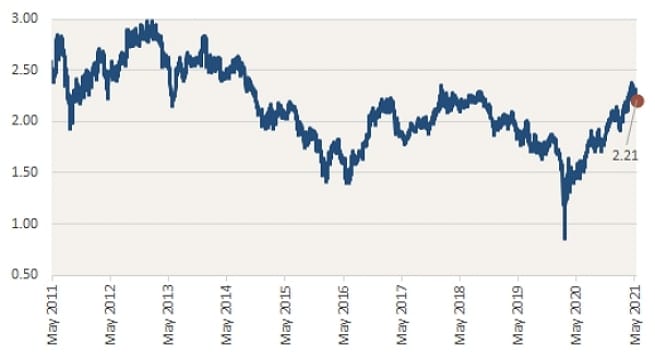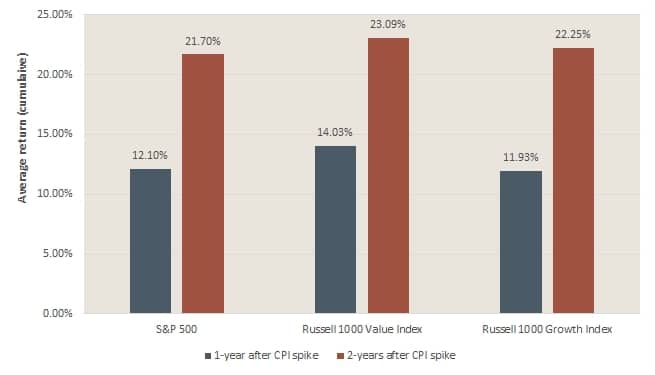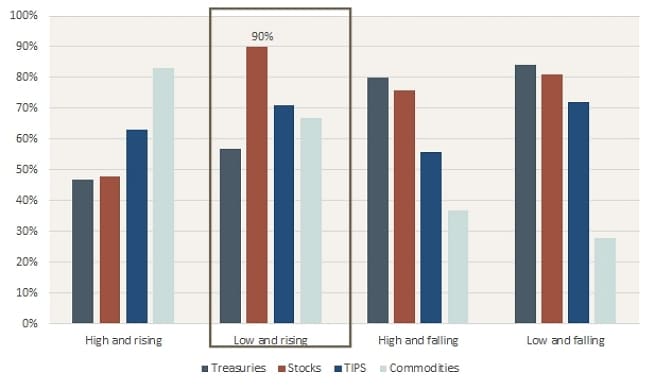Don’t Fear The Reaper Inflation
Moving past scary headlines and looking at market data, the story of inflation is much, much different. In the United States, the 5-year Breakeven Inflation Rate (T5YIE) stands at a mere 2.43%. Looking 10 years forward, the market is signaling projected inflation of 2.21%. That’s nearly in line with the Fed’s long-term target of 2%.
5-year, 5-year forward inflation expectation rate

Who should we believe? Should we listen to the news networks looking to boost ratings, or the financial markets which are designed to allocate trillions of dollars of capital? Our vote is with the financial markets. If we do enter an environment of sustained price increases, inflation is not entirely a bad thing.
A healthy level of inflation attracts capital and encourages spending, which is economically stimulative.
When the U.S. Consumer Price Index (CPI) spiked to 4.2% year-over-year in April 2021, inflation became the focus of any conversation that involved financial markets. CPI further increased to 5% year-over-year in May 2021. Contrary to what the media has reported, equities have performed well after a spike in year-over-year CPI. The chart below highlights the 5 largest monthly spikes in CPI over the last 20 years.
Average returns following a spike in CPI (5 largest readings, May 2001 – May 2021)

Equities have historically proven to be a reasonable hedge against inflation given the ability of companies to absorb price increases and pass them down the supply chain to their customers. Even if the inflation spikes used to compile the data above proved transitory, which we believe the most recent readings may, equities have displayed a consistent ability to outpace inflation when coming off a low base. As pointed out in the chart below, stocks have historically outperformed inflation 90% of the time when inflation readings are rising off of a low base.
Percentage of rolling 12-month periods in which returns exceeded inflation (1973 – 2020)

So despite what you may be hearing in popular media, we view the likelihood of prolonged inflation in the immediate term as minimal.
What would change our opinion?
To start, we are actively monitoring the labor force and consumer demand.
On the labor front, wages have been on the rise thanks to a shortage in the supply of workers. If this imbalance between supply and demand persists and there is an indication of a more permanent mismatch between employer desires and potential employee skill sets, wage inflation may be a concern to be taken seriously. However, it’s possible that this lack of equilibrium in the labor market is driven more by some combination of fear, unemployment benefits, and childcare/responsibilities at home. We will continue to monitor the labor market closely. We will dive into national and regional labor surveys for additional intelligence as unemployment benefits roll-off.
Upon emerging from lockdown, consumers found themselves in a unique position. Through stimulus payments, a lack of spending on services, and a spike in the personal savings rate, household balance sheets were healthier than at the onset of the recession. As such, there is pent-up demand, and individuals may elect to draw down those elevated savings in their entirety regardless of high prices. Conversely, consumers may elect to tread lightly, spending some of the savings pile on that vacation they were unable to take last year but continuing to save at an above average rate amid high prices and the scarring that any recession can invoke. Through the summer, we will have our eyes on personal spending, retail sales, and consumer sentiment surveys.
If we do face sustainably high levels of inflation, it is important to remember that investors have plenty of tools at their disposal to protect and grow capital. Regardless of the broad media focus on the dreaded word inflation, we maintain a focus on filtering out the noise, digesting the relevant data, and positioning portfolios accordingly.
Read more articles on Inflation here.
Expressions of opinion are as of this date and are subject to change without notice. The information provided does not constitute tax, legal, accounting, or other professional advice and is without warranty as to the accuracy or completeness of the information. Any information provided is not a complete summary or statement of all available data necessary for making an investment decision and does not constitute a recommendation to buy, hold or sell any security. The information has been obtained from sources considered to be reliable, but we do not guarantee that the foregoing material is accurate or complete. There are limitations associated with the use of any method of securities analysis. Indices are included for informational purposes only; investors cannot invest directly in any index. Every investor’s situation is unique, and you should consider your investment goals, risk tolerance and time horizon before making any investment. Prior to making an investment decision, please consult with your financial advisor about your individual situation. Past performance does not guarantee future results. Investing involves risk and you may incur a profit or loss regardless of strategy selected. There is no guarantee that any statements, opinions or forecasts provided herein will prove to be correct.

